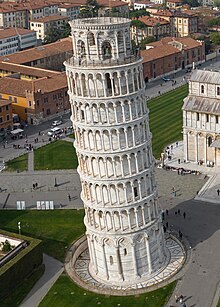| Leaning Tower of Pisa | |
|---|---|
Torre pendente di Pisa | |
 Leaning Tower of Pisa in 2022 | |
| Religion | |
| Affiliation | Catholic Church |
| Ecclesiastical or organizational status | Active |
| Location | |
| Location | Pisa, Italy |
| Geographic coordinates | 43°43′23″N 10°23′47″E / 43.72306°N 10.39639°E |
| Architecture | |
| Architect(s) | Diotisalvi (?) Bonanno Pisano (?) |
| Style | Romanesque |
| Groundbreaking | 1173 |
| Completed | 1372 |
| Specifications | |
| Height (max) | 55.86 m (183 ft 3 in) |
| Materials | |
| Website | |
| www | |
| Part of | Piazza del Duomo, Pisa |
| Criteria | Cultural: i, ii, iv, vi |
| Reference | 395 |
| Inscription | 1987 (11th Session) |
The Leaning Tower of Pisa (Italian: torre pendente di Pisa [ˈtorre penˈdɛnte di ˈpiːza, - ˈpiːsa][1]), or simply the Tower of Pisa (torre di Pisa), is the campanile, or freestanding bell tower, of Pisa Cathedral. It is known for its nearly four-degree lean, the result of an unstable foundation. The tower is one of three structures in Pisa's Cathedral Square (Piazza del Duomo), which includes the cathedral and Pisa Baptistry.
The height of the tower is 55.86 metres (183 feet 3 inches) from the ground on the low side and 56.67 m (185 ft 11 in) on the high side. The width of the walls at the base is 2.44 m (8 ft 0 in). Its weight is estimated at 14,500 tonnes (16,000 short tons).[2] The tower has 296 or 294 steps; the seventh floor has two fewer steps on the north-facing staircase.
The tower began to lean during construction in the 12th century, due to soft ground which could not properly support the structure's weight. It worsened through the completion of construction in the 14th century. By 1990, the tilt had reached 5.5 degrees.[3][4][5] The structure was stabilized by remedial work between 1993 and 2001, which reduced the tilt to 3.97 degrees.[6]
- ^ "DiPI Online". Dizionario di Pronuncia Italiana (in Italian). Archived from the original on 30 October 2020. Retrieved 26 December 2020.
- ^ "Leaning Tower of Pisa Facts". Leaning Tower of Pisa. Archived from the original on 11 September 2013. Retrieved 5 October 2013.
- ^ "Europe | Saving the Leaning Tower". BBC News. 15 December 2001. Archived from the original on 21 September 2013. Retrieved 9 May 2009.
- ^ "Tower of Pisa". Archidose.org. 17 June 2001. Archived from the original on 26 June 2009. Retrieved 9 May 2009.
- ^ "Leaning Tower of Pisa (tower, Pisa, Italy)". Britannica Online Encyclopedia. Archived from the original on 8 March 2013. Retrieved 9 May 2009.
- ^ "Leaning tower of Pisa loses crooked crown". Irish News. Archived from the original on 28 November 2020. Retrieved 10 June 2020.